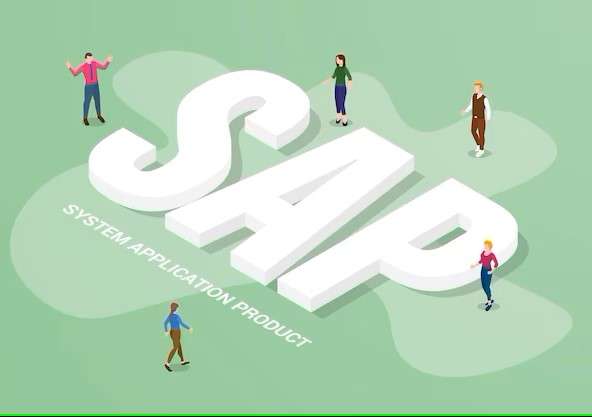SAP software, also known as Systems, Applications, and Products in Data Processing, is a leading enterprise resource planning (ERP) solution that has transformed the way businesses operate and manage their processes. SAP software provides organizations with a comprehensive suite of integrated applications that cover various aspects of business operations, including finance, sales, procurement, human resources, and more.
With its origins dating back to the 1970s, SAP has grown to become one of the most widely used ERP systems globally, trusted by organizations of all sizes and across various industries. The power of SAP lies in its ability to streamline and automate business processes, improve operational efficiency, and provide real-time insights for better decision-making.
SAP software is designed to address the complex needs of modern businesses by integrating different functions and departments into a unified platform. This integration allows for seamless data flow, eliminates silos, and enables organizations to have a holistic view of their operations.
Moreover, SAP offers a wide range of modules and solutions that cater to specific business needs. Whether it’s financial management, sales and distribution, supply chain management, or human capital management, SAP provides robust and customizable solutions that can be tailored to fit the unique requirements of each organization.
The adoption of SAP software brings numerous benefits to organizations. It enhances productivity by automating repetitive tasks, reduces manual errors, and facilitates collaboration across teams. With SAP, businesses gain access to accurate and real-time data, enabling them to make informed decisions and respond quickly to market changes.
In addition, SAP software supports scalability, allowing businesses to grow and adapt without limitations. As organizations expand, SAP provides the flexibility to add new functionalities and modules to meet evolving needs.
In this blog post, we will delve deeper into the key features of SAP software, explore its benefits, discuss the various modules available, and highlight some industries and organizations that have successfully implemented SAP. We will also touch upon implementation considerations, training opportunities, and future trends in SAP.
SAP software has undoubtedly revolutionized the way businesses operate, offering a powerful toolset for efficient and effective management of resources. Join us as we explore the world of SAP and discover the immense possibilities it holds for organizations across the globe.

Key Features of SAP Software:
- Integration: One of the key features of SAP software is its ability to integrate different business functions and departments into a unified system. This integration enables seamless data flow across various modules, ensuring consistency and accuracy of information. It eliminates the need for multiple standalone systems and improves collaboration between teams.
- Customization: SAP software offers a high level of customization to meet the specific needs of different organizations. Businesses can tailor the system to align with their processes, workflows, and industry requirements. Customization options include configuring workflows, defining user roles and permissions, adapting reporting formats, and more.
- Scalability: SAP software is designed to support the growth and scalability of organizations. As businesses expand or undergo structural changes, SAP can accommodate new business units, locations, and increased transaction volumes. It provides the flexibility to add new modules and functionalities as needed, ensuring that the system can adapt to evolving business needs.
- Analytics and Reporting: SAP software provides powerful analytics and reporting capabilities, allowing organizations to gain valuable insights from their data. With built-in reporting tools and customizable dashboards, users can create meaningful visualizations, track key performance indicators (KPIs), and generate comprehensive reports for informed decision-making.
- Mobility and Cloud Readiness: SAP has embraced the shift towards mobile and cloud computing. Organizations can access SAP software and data remotely through mobile devices, enabling flexibility and agility in operations. Additionally, SAP offers cloud-based deployment options, allowing businesses to leverage the benefits of scalability, accessibility, and cost-effectiveness associated with cloud computing.
SAP Modules and Solutions
SAP software offers a wide range of modules and solutions that cater to different aspects of business operations. Let’s explore some of the key modules commonly used by organizations:
- SAP ERP (Enterprise Resource Planning): SAP ERP is the core module that integrates various business functions such as finance, human resources, procurement, sales, and supply chain management. It provides a centralized platform to manage and streamline these critical processes, enabling organizations to optimize resource allocation, enhance efficiency, and improve decision-making.
- SAP CRM (Customer Relationship Management): SAP CRM focuses on managing customer interactions and relationships. It helps organizations effectively track and manage customer data, sales activities, marketing campaigns, and customer service processes. By providing a holistic view of customers, SAP CRM enables businesses to deliver personalized experiences, improve customer satisfaction, and drive customer loyalty.
- SAP SCM (Supply Chain Management): SAP SCM module optimizes the supply chain processes, including procurement, production planning, inventory management, and logistics. It enables organizations to enhance supply chain visibility, streamline operations, reduce costs, and improve overall efficiency. SAP SCM facilitates collaboration with suppliers, distributors, and partners to ensure smooth end-to-end supply chain operations.
- SAP HCM (Human Capital Management): SAP HCM module focuses on managing human resources and workforce-related processes. It covers areas such as employee recruitment, onboarding, performance management, talent development, and payroll. SAP HCM helps organizations effectively manage their workforce, align HR processes with business goals, and improve employee engagement and productivity.
- SAP BI (Business Intelligence): SAP BI module offers robust reporting, analytics, and data visualization capabilities. It enables organizations to extract, transform, and analyze data from various sources, providing actionable insights for strategic decision-making. With SAP BI, businesses can create interactive reports, dashboards, and data visualizations to monitor key metrics, identify trends, and uncover business opportunities.
These are just a few examples of the modules available in SAP software. Each module can be further customized and extended to meet the specific needs of different industries and organizations. In the following sections, we will delve deeper into each module, exploring their features, benefits, and real-world use cases.

Benefits of Implementing SAP Software
Implementing SAP software can bring several benefits to organizations across various industries. Let’s explore some of the key advantages of implementing SAP software:
- Process Integration and Efficiency: SAP software offers a comprehensive suite of integrated applications that streamline and automate various business processes. By integrating different functional areas like finance, sales, procurement, human resources, and supply chain, SAP software enables organizations to achieve higher process efficiency, eliminate manual tasks, reduce errors, and improve overall productivity.
- Enhanced Data Visibility and Decision Making: SAP software provides a centralized database where organizations can store and manage their data. This centralized approach ensures data consistency, accuracy, and real-time visibility across different departments. With access to reliable and up-to-date information, decision-makers can make informed and data-driven decisions, leading to improved business outcomes.
- Improved Collaboration and Communication: SAP software facilitates seamless collaboration and communication among different teams and departments within an organization. With shared access to information and integrated workflows, employees can collaborate effectively, exchange information, and work towards common goals. This leads to improved cross-functional coordination, faster decision-making, and enhanced productivity.
- Scalability and Flexibility: SAP software is designed to scale with the growth and evolving needs of organizations. It can accommodate expanding user bases, increasing transaction volumes, and changing business requirements. SAP software offers flexibility through its modular structure, allowing organizations to select and implement specific modules based on their unique needs. This scalability and flexibility enable organizations to adapt to changing market conditions and support their long-term growth strategies.
- Enhanced Customer Experience: SAP software enables organizations to deliver superior customer experiences. By integrating customer data, sales processes, and customer service functionalities, organizations can gain a comprehensive view of their customers. This enables personalized interactions, faster response times, and improved customer satisfaction. With better customer insights, organizations can tailor their offerings, anticipate customer needs, and build long-lasting relationships.
- Regulatory Compliance and Risk Management: SAP software incorporates robust security and compliance features, helping organizations meet regulatory requirements and manage risks effectively. It provides tools for data privacy, access controls, audit trails, and compliance reporting. With these capabilities, organizations can ensure data security, adhere to industry standards, and mitigate the risks associated with data breaches or non-compliance.
- Competitive Advantage: Implementing SAP software can give organizations a competitive edge in the market. By optimizing business processes, improving operational efficiency, and enabling data-driven decision-making, organizations can enhance their agility, responsiveness, and innovation capabilities. This can lead to cost savings, increased market share, improved customer satisfaction, and differentiation from competitors.
In conclusion, implementing SAP software offers numerous benefits, ranging from process integration and efficiency to enhanced data visibility, collaboration, and competitive advantage. It empowers organizations to optimize their operations, make informed decisions, and drive business growth in a rapidly changing business landscape.

Industries and Organizations Using SAP
SAP software is widely adopted across various industries and organizations, ranging from small businesses to large enterprises. Let’s explore some of the industries and organizations that leverage SAP software:
- Manufacturing: SAP software is extensively used in the manufacturing industry to streamline production processes, manage supply chains, and optimize inventory levels. It helps manufacturers to monitor and control their operations, track product quality, and ensure efficient resource utilization.
Example: A leading automotive manufacturer implements SAP software to integrate its manufacturing processes, manage its global supply chain, and enhance collaboration with suppliers.
- Retail and Consumer Goods: In the retail and consumer goods industry, SAP software plays a crucial role in managing inventory, sales, and customer relationships. It helps retailers to improve demand forecasting, optimize pricing strategies, and provide personalized shopping experiences to customers.
Example: A multinational retail chain utilizes SAP software to centralize its inventory management, automate sales processes, and analyze customer buying patterns for targeted marketing campaigns.
- Financial Services: Banks, insurance companies, and other financial institutions rely on SAP software to streamline their operations, ensure regulatory compliance, and enhance customer service. It enables them to manage complex financial transactions, assess risks, and provide personalized financial solutions.
Example: A global bank adopts SAP software to automate its core banking processes, facilitate seamless online banking services, and enable efficient regulatory reporting.
- Healthcare: SAP software is employed in the healthcare sector to improve patient care, manage electronic health records, and optimize healthcare delivery processes. It enables healthcare providers to integrate clinical, administrative, and financial systems, leading to better patient outcomes and operational efficiency.
Example: A large hospital implements SAP software to digitize patient records, streamline appointment scheduling, and enhance communication between healthcare providers.
- Energy and Utilities: SAP software is utilized in the energy and utilities sector to manage complex operations, such as power generation, transmission, and distribution. It helps organizations monitor energy consumption, optimize resource allocation, and improve sustainability practices.
Example: An energy company leverages SAP software to optimize its energy production, monitor grid performance, and enable real-time energy consumption analysis for customers.
- Public Sector: Government organizations and public sector entities use SAP software to improve administrative processes, enhance citizen services, and ensure transparency in governance. It enables efficient management of public funds, streamlines procurement processes, and facilitates effective resource allocation.
Example: A government agency deploys SAP software to automate its financial management, track public expenditures, and improve transparency in budget allocations.
These are just a few examples of the industries and organizations that benefit from SAP software. However, SAP’s reach extends to various other sectors, including telecommunications, transportation, agriculture, and more. The flexibility and adaptability of SAP software make it suitable for organizations of all sizes, from startups to multinational corporations, across diverse industries.

Implementation and Integration Considerations
Implementing and integrating SAP software into an organization’s existing systems and processes requires careful planning and consideration. Here are some key factors to consider during the implementation and integration process:
- Project Planning: It is essential to establish a well-defined project plan that outlines the scope, objectives, timeline, and resources required for the SAP implementation. This includes identifying key stakeholders, allocating responsibilities, and setting realistic expectations for the implementation process.
- Customization and Configuration: SAP software provides a range of modules and functionalities that can be customized to meet specific business requirements. During the implementation, organizations need to carefully assess their needs and configure the software accordingly. Customizations should align with the organization’s processes while minimizing complexity and ensuring future scalability.
- Data Migration: Migrating existing data to the SAP system is a critical aspect of the implementation process. Organizations must evaluate the quality and integrity of their data, cleanse and map it to the appropriate SAP structures, and ensure a smooth transition to the new system. Data migration should be meticulously planned and executed to avoid data loss or discrepancies.
- User Training and Change Management: Introducing SAP software often requires changes in workflows and processes for the organization and its employees. Proper user training and change management initiatives are crucial to ensure a smooth transition and user adoption. Training programs should be designed to familiarize users with the new system, its features, and how it aligns with their roles and responsibilities.
- Integration with Existing Systems: Organizations may have existing systems and applications that need to be integrated with SAP software for seamless data exchange and process automation. Integration considerations include identifying integration points, selecting suitable integration technologies (such as APIs or middleware), and establishing data synchronization mechanisms.
- Scalability and Future Growth: Organizations should assess the scalability of the SAP implementation to accommodate future growth and evolving business needs. The system architecture and infrastructure should be designed to handle increasing data volumes, user load, and additional functionalities as the organization expands.
- Testing and Quality Assurance: Thorough testing is essential to ensure the stability and reliability of the SAP implementation. This includes unit testing, integration testing, and user acceptance testing to validate system functionality, data accuracy, and performance. Quality assurance processes should be implemented to identify and address any issues or bugs before the system goes live.
- Post-Implementation Support and Maintenance: Once the SAP system is implemented, ongoing support and maintenance are necessary to address user queries, perform system upgrades, and ensure the system’s smooth operation. Organizations should establish appropriate support mechanisms, such as help desks or dedicated support teams, to assist users and resolve any issues that may arise.
By considering these implementation and integration factors, organizations can optimize the adoption of SAP software and maximize the benefits it offers. A well-executed implementation ensures a seamless transition, improved operational efficiency, and enhanced business performance.
Training and Certification Opportunities
Training and certification programs play a crucial role in enabling individuals and organizations to leverage the full potential of SAP software. Here are key aspects to consider regarding training and certification opportunities:
- Training Programs: SAP offers comprehensive training programs designed to equip individuals with the necessary knowledge and skills to effectively work with SAP software. These programs cover various modules and functionalities, catering to different roles and responsibilities within an organization. Training can be conducted through a combination of instructor-led classes, online courses, or self-paced learning modules.
- Role-based Training: SAP training programs are designed to cater to specific job roles, such as consultants, developers, administrators, or end-users. Each role requires different levels of expertise and proficiency in utilizing SAP software. Role-based training ensures that individuals acquire the necessary skills relevant to their specific job requirements.
- Hands-on Experience: Practical experience is vital for individuals to apply their knowledge and develop proficiency in using SAP software. Training programs often include hands-on exercises, case studies, and simulations that provide participants with real-world scenarios to practice their skills. Hands-on experience enhances understanding, problem-solving abilities, and confidence in utilizing SAP software effectively.
- Certification Exams: SAP offers certification exams to validate individuals’ proficiency in using SAP software. Certification exams are conducted for various modules and job roles and provide individuals with recognized credentials that demonstrate their expertise. Achieving SAP certification can enhance career prospects, credibility, and recognition within the industry.
- Continuous Learning: SAP software and technologies evolve over time, introducing new features and functionalities. It is essential for individuals to stay updated with the latest advancements and best practices. SAP provides opportunities for continuous learning through ongoing training programs, webinars, conferences, and communities where individuals can engage with experts and peers to exchange knowledge and experiences.
- Organizational Training Initiatives: Organizations can also invest in training programs for their employees to enhance their SAP software skills. This ensures that the workforce is equipped to effectively utilize SAP software, maximizing its benefits for the organization. By aligning training initiatives with organizational goals and business requirements, companies can foster a culture of continuous learning and professional development.
- Partner and Third-Party Training: In addition to SAP’s official training programs, there are also partner organizations and third-party training providers that offer SAP-related training. These organizations may provide specialized training, customized courses, or additional resources to complement SAP’s official training offerings. Exploring these options can provide individuals and organizations with a broader range of training opportunities.
Training and certification opportunities empower individuals to become proficient in working with SAP software, enhancing their career prospects and enabling them to contribute effectively to their organizations. By investing in training and certification, individuals and organizations can stay competitive in the rapidly evolving landscape of SAP technology and maximize the value derived from using SAP software.
Future Trends and Innovations in SAP
As a leading provider of enterprise software solutions, SAP continuously strives to stay at the forefront of technology and innovation. Here are some key future trends and innovations to watch out for in the world of SAP:
- Intelligent Technologies: SAP is embracing intelligent technologies such as artificial intelligence (AI), machine learning (ML), and robotic process automation (RPA) to enhance its software offerings. These technologies enable advanced data analytics, predictive capabilities, and automation of repetitive tasks, empowering organizations to make data-driven decisions and streamline their operations.
- Cloud-Based Solutions: Cloud computing is revolutionizing the software industry, and SAP is actively investing in cloud-based solutions. SAP Cloud Platform provides a scalable and flexible environment for deploying and running SAP applications. Cloud-based solutions offer benefits such as improved accessibility, cost-effectiveness, and agility, enabling organizations to quickly adapt to changing business needs.
- Internet of Things (IoT) Integration: The integration of IoT with SAP software is unlocking new possibilities for businesses. By connecting physical devices, sensors, and machines, organizations can gather real-time data and gain insights to optimize processes, improve efficiency, and deliver enhanced customer experiences. SAP offers IoT solutions and platforms to enable seamless integration and management of IoT data within the enterprise.
- Advanced Analytics: SAP is enhancing its analytics capabilities by leveraging technologies such as in-memory computing and big data processing. With tools like SAP HANA, organizations can analyze vast amounts of data in real-time, uncovering valuable insights and patterns. Advanced analytics enables organizations to make informed decisions, identify market trends, and drive innovation.
- Industry-Specific Solutions: SAP recognizes the unique requirements of different industries and continues to develop industry-specific solutions. Whether it’s healthcare, manufacturing, retail, or finance, SAP aims to provide tailored solutions that address specific industry challenges and meet regulatory compliance standards. These industry-specific solutions offer preconfigured processes and functionalities designed to streamline operations and deliver industry best practices.
- User Experience and Interface: SAP is focusing on enhancing user experience (UX) and providing intuitive interfaces across its software solutions. The goal is to make SAP software more user-friendly, enabling users to easily navigate, interact, and derive value from the system. This includes responsive design, mobile applications, and personalized experiences that cater to individual user roles and preferences.
- Blockchain Integration: SAP is exploring the integration of blockchain technology into its software solutions. Blockchain offers secure, transparent, and immutable transaction records, making it ideal for applications such as supply chain management, financial transactions, and contract management. By leveraging blockchain technology, SAP aims to enhance data security, traceability, and trust in business processes.
These are just a few of the future trends and innovations that SAP is actively pursuing. As technology continues to evolve, SAP remains committed to delivering cutting-edge solutions that enable organizations to stay competitive, drive digital transformation, and unlock new opportunities for growth. By embracing these trends, businesses can harness the power of SAP software to thrive in the digital era.
Conclusion:
SAP software has revolutionized the way businesses operate by providing comprehensive enterprise solutions that streamline processes, enable data-driven decision-making, and drive digital transformation. In this blog post, we explored the key aspects of SAP software, including its definition, benefits, industries using it, implementation considerations, training opportunities, and future trends.
By implementing SAP software, organizations can experience numerous benefits such as improved operational efficiency, enhanced data management, better customer relationship management, and increased competitiveness. The scalability, flexibility, and industry-specific solutions offered by SAP make it a preferred choice for businesses across various sectors.
However, it’s important to consider several factors when implementing SAP software, such as the complexity of integration, training requirements, and ongoing support. Organizations should carefully plan their implementation strategy, engage with experienced SAP consultants, and invest in comprehensive training programs to maximize the value derived from SAP software.
Furthermore, SAP offers a range of training and certification opportunities that enable individuals to develop their skills and enhance their career prospects. By becoming certified in SAP software, professionals can demonstrate their expertise and gain a competitive edge in the job market.
Looking ahead, SAP is actively embracing future trends and innovations, such as intelligent technologies, cloud computing, IoT integration, advanced analytics, and user experience enhancements. These innovations will continue to shape the landscape of SAP software and empower organizations to unlock new possibilities, drive innovation, and stay ahead in the digital era.
In conclusion, SAP software is a powerful tool that empowers organizations to optimize their operations, make data-driven decisions, and achieve their business objectives. By harnessing the capabilities of SAP software, businesses can embark on a journey of digital transformation and gain a competitive advantage in today’s fast-paced and ever-changing business landscape.
